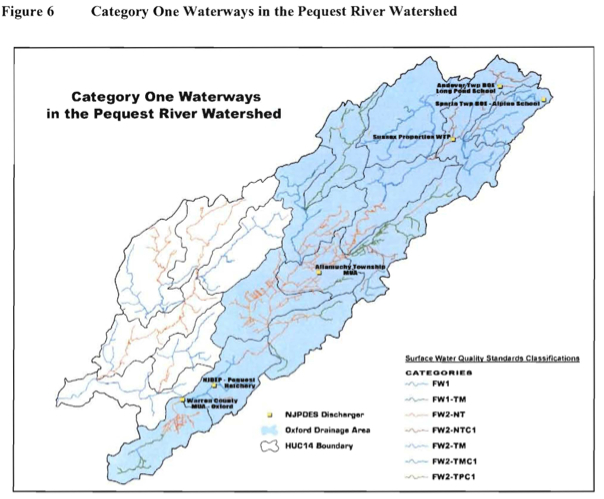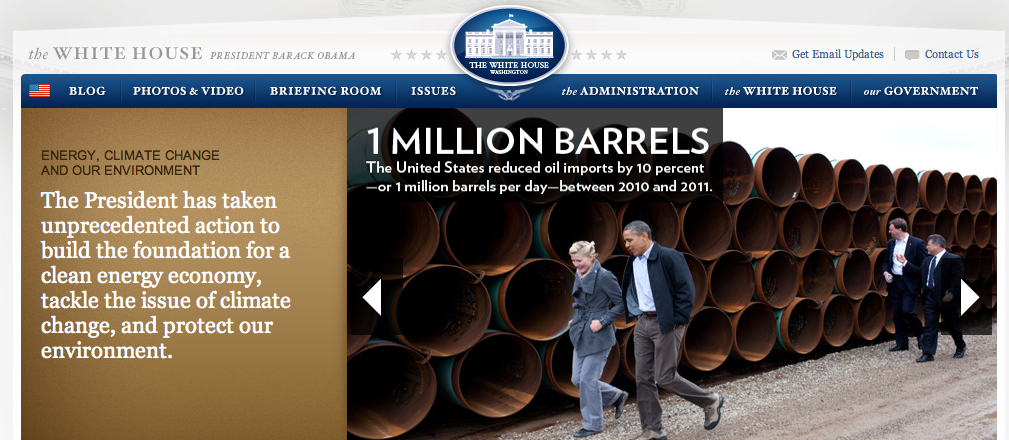DEP Fails Clean Water Metric – EPA Battle Brewing
EPA Oversight Likely To Block NJ’s Attempt To Rollback Stream Buffers
[Update below]
Two brief but important things for clean water and land use regulation in NJ.
I) Clean Water Act TMDL cleanup program floundering
First, I had hoped that Governor Christie’s veto of legislation – that would have required that DEP develop a federal Clean Water Act “Total Maximum Daily Load” (TMDL) cleanup plan for Barnegat Bay – would have prompted a firestorm of critical media inquiries and legislative oversight of the DEP’s implementation of the federally delegated Clean Water Act TMDL program.
I figured oversight was warranted not only as a result of Christie’s Veto, but due to DEP’s own Reports and the Asbury Park Press’ series about poor and declining water quality in NJ.
Of course, oversight also is justified by DEP Commissioner Bob Martin’s pledge to develop and be held accountable to performance metrics.
But none of that happened.
So, I figured I’d do it myself.
A simple Google produces the data – but you have to know where to look – DEP recently revised the webpage and no longer makes access to the TMDL program user friendly. With that kind of lousy performance, I can understand why.
[Note: and if you miraculously managed to follow the links and actually found any TMDL, you can find this revealing statement of concession, or “substantial relief” provided by DEP (on page 42):
Completion of the TMDL study allows the Department to substitute a TMDL-based water quality based effluent limit in place of the [stricter] 0.1 mg/L end-of-pipe criterion that would be required for a discharge to an impaired water, absent a TMDL. This was the limit initially applied to the Allamuchy Township, Pequest Fish Hatchery and Warren County MTJA-Oxford facilities and which was adjudicated.
The Department is mindful of the need to align requirements for treatment with an associated environmental benefit. To that end, this TMDL provides substantial relief from the initially imposed limit and incorporates additional seasonal relief in recognition of the higher 7Q10 flows that occur in winter months. …
If, despite the significant relief already provided, the reductions required are believed to result in substantial and widespread social and economic impact, the Department provides a mechanism for the regulated entity to pursue relief from the required reduction in the form of a variance, as set forth in the SWQS at N.J.A.C. 7:9B 1.8 and 1.9 (see also N.J.A.C. 7:14A-l1.8).
So, not only is DEP doing far too few TMDL’s, the ones they are doing are designed to provide relief from stricter pollution limits – in other words, DEP is using the TMDL process to gut standards. Full disclosure: I worked on the 0.1 mg/L phosphorus effluent standard while at DEP. end note].
As the above bar chart reveals, the Christie DEP clean water performance is abysmal, as measured by something DEP has complete control over – production and implementation of TMDL cleanup plans for NJ’s severely polluted waterways.
But, it looks like DEP is following the Governor’s Veto in administering the TMDL program.
II) Any Rollbacks in C1 Stream Buffers Will Trigger EPA Oversight
Second, changing gears.
As recommended by the Christie DEP Transition Report and the “regulatory relief” provisions of Executive Order #2, DEP will soon propose new rules that would rollback the controversial “Category One” (C1) 300 foot stream buffers.
That rollback effort likely will be blocked by USEPA.
That’s because the NJ State DEP 300 foot Category One (C1) stream buffers are now federally enforceable in NJ.
To demonstrate compliance “waste load allocations” under the TMDL, as DEP noted in the TMDL:
As part of the requirements under the municipal storm water permitting program, municipalities are required to adopt and implement municipal stonnwater management plans and stonnwater control ordinances consistent with the requirements of the stonnwater management rules. As such, in addition to changes in the design of projects regulated through the RSIS and DLUR, municipalities have been updating their regulatory requirements to provide the additional protections in the Stormwater Management Rules.
Thus, federal enforcement is the result of EPA’s recognition of buffers as a non-point source pollution control “Best Management Practice” (BMP) in the “Waste Load Allocation (WLA) of the “TMDL” program under Section 303 of the Clean Water Act.
Now there’s a mouthful! (see glossary of TMDL terms).
EPA has memorialized this policy in EPA’s approval of DEP’s proposed TMDL’s, where EPA wrote:
Tier B Municipalities shall enforce stormwater control ordinance(s) when approved in accordance with N.J.A.C. 7:8-4. Within 24 months from the effective date of permit authorization Tier B Municipalities shall:
- Ensure adequate long-term operation and maintenance of BMPs on property not owned or operated by the municipality;
- Enforce, through the stormwater control ordinance(s) or a separate ordinance compliance with the standards set forth in Attachment A of the permit to control passage of solid and floatable materials through storm drain inlets for storm drain inlets not installed by the Tier B Municipality.
Pursuant to the New Jersey Stormwater Management Rules, there is a 300-foot special water resource protection area (S WRP A) around Category One (C 1) waterbodies and their intermittent and perennial tributaries, within the HUC 14 subwatershed. C1waters receive the highest form ofwater quality protection in the state, which prohibits any measurable deterioration in the existing water quality.
In addition to EPA’s formal recognition of the NJ stream buffers in the TMDL program, EPA has additional federal Clean Water Act based review and approval powers over NJ DEP C1 buffers.
NJ DEP’s C1 buffers are a water quality BMP codified in the NJ Stormwater Management Regulations. The federal EPA hook is created by the fact that compliance with the Stormwater Management Regulations is required under NJ DEP’s rules implementing the EPA delegated Municipal Stormwater Permit program under the Clean Water Act.
NJ C1 waterway designations are codified in the EPA reviewed and approved Surface Water Quality Standards. NJ DEP’s C1 buffers are also an “anti-degradation implementation procedure” under the EPA approved NJ Surface Water Quality Standards.
Therefore, EPA has approved NJ’s stream buffers in the Municipal Stormwater Permit program and the Surface Water Quality Standards programs. Any substantive change to the buffers would trigger EPA review and approval.
In the event that DEP proposes any rollback of the C1 buffers, we will be seeking EPA intervention to block that move under the federal Clean Water Act.
We will keep you posted.
[Update: in addition to using the TMDL process to address administrative challenges to permits (an absurd priority, which is supposed to be driven by water quality concerns, not litigation) and to undermine and weaken stricter effluent standards, the TMDL process itself has some pretty perverse stuff.
First of all, wetlands and forests are considered “pollution sources”.
But, that’s not all!. This is my favorite perversity: DEP considers development of farmland as an means to improve water quality! Yup! See page 45:
Comment 11: The Andover Planned Unit Development (PUD) will change the land use from agriculture to residential. Will this land use change be taken into account as the NPS reductions required to be accomplished ‘by Andover Township (Tier A Municipality under NJDEP stonnwater regulations) and/or Andover Borough (Tier B Municipality) are calculated? Will the Andover PUD’s stonnwater best management practices (BMPs) that are already a feature of the project be given proper NPS reduction credit? Devise a method of crediting for BMPs that already reduce their runoff load instead of asking them to further reduce their loads when other nonpoint source dischargers with the same land use have not reduced their loads at all. (4)
Response to Comment 11: As stated in the TMDL, the contribution of TP associated with residential development is less than that associated with agricultural land use. Therefore, it is reasonable to expect that a reduction in land use load will result with this conversion.
Second, and worse, as noted above, DEP used the TMDL to provide “significant relief”.
Now DEP did not apply this relief just anywhere, like in a heavily polluted urban river.
DEP provided relief from pollution controls to sewage treatment plants that discharge into the most environmentally sensitive trout streams and rivers in NJ! The Pequest in Warren County:




